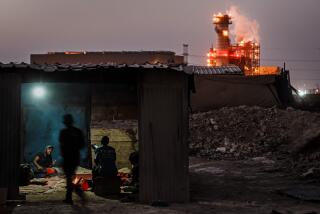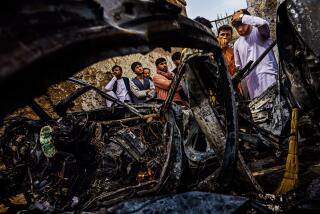Yazidi sect has long been a target of persecution
- Share via
IRBIL, IRAQ — To the Yazidis worldwide, Tuesday was No. 73.
Up until that day, the secretive religious sect had counted 72 campaigns against it at the hands of Turks, Arabs, Persians and Kurds throughout its long history, said Aidan Sheikh-Kalo, director of the Yazidi Cultural Center.
Yazidi society has been on the run since a spurt of religiously motivated violence began in April. Now, after a devastating attack that killed more than 250 of them, many worry about their future in Iraq.
“We left our homes in a hurry because we knew we were in danger,” said Sheikh-Kalo, a 30-year-old Yazidi who was forced to move to the autonomous Kurdish region from Mosul after suspected insurgents began issuing calls to kill all members of his sect.
“Our homes have been taken over by terrorists,” he said. “They’ve taken everything from us.”
Sheikh-Kalo is grieving the loss of three relatives killed in the blasts, which targeted villages near the town of Sinjar, along the Syrian border.
Despite periodic pogroms and persistent bigotry against their religion, Sheikh-Kalo said, Yazidis had been left pretty much alone since the end of Saddam Hussein’s regime.
“There were cases of violence, but they weren’t targeting Yazidis specifically,” he said. “They were victims of the general situation.”
But Sheikh-Kalo and his seven-member organization, along with their families, left Mosul on April 25, after suspected members of the Al Qaeda-linked Islamic State of Iraq distributed leaflets at mosques calling for attacks on Yazidis.
It was just days after 21 Yazidi laborers were pulled off a bus and shot and killed in apparent retaliation for the stoning death of a 17-year-old Yazidi girl who had converted to Islam to marry.
Mainstream Yazidis were horrified by the stoning, which was filmed and broadcast on the Internet. It highlighted differences between more urban Yazidis and those still strongly tied to their tribal roots.
Many Yazidis fear that the fatal attack on the teenager served to increase prejudice against their sect, which draws heavily from tenets of Zoroastrianism as well as Islam and other faiths. The sect is thought to number 500,000, and its members are scattered across the Middle East
“Many Arabs believe that we are barbarians, that we are infidels,” Sheikh-Kalo said.
Yazidis have been mired in poverty since 1975, when Hussein’s regime forcibly removed them from their mountain villages and put them into camps to quell an insurgency, he said.
They left the camps for their old towns and cities after the establishment of the autonomous Kurdish region in 1991, only to hurry back once the violence began to edge closer to them.
There were few resources and services near the targeted towns, which included Qahtaniya and Jazeera. Unlike Sinjar, they are not under the unofficial control of the Kurdish political parties and must fend for themselves, Sheikh-Kalo said.
“Terrorists can enter this area easily because there’s no one stopping them,” he said.
--
More to Read
Sign up for Essential California
The most important California stories and recommendations in your inbox every morning.
You may occasionally receive promotional content from the Los Angeles Times.













